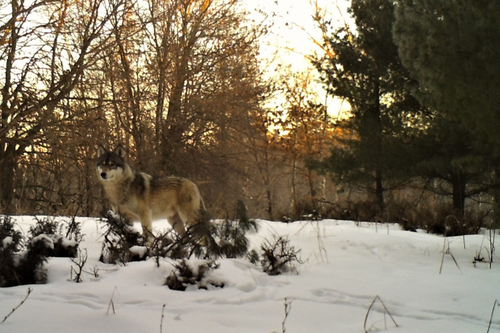Do predators shape ecosystems? Trophic cascades curtailed by prey use of dangerous places during safe times

By simulating wolf activity in the grasslands of central Minnesota, University of Minnesota researchers demonstrated that deer altered their behavior in response to the fear of predation in specific ways that halt the cascade of predator effects on plant and soil communities.
“Traditionally, it was believed that predators shape ecosystems by changing the activity of the prey and that the prey’s changes in behavior would then have cascading consequences on organisms in lower trophic levels, such as soil and plants,” said lead author Meredith Palmer, a former graduate student and postdoctoral researcher with the U of M College of Biological Sciences and current postdoctoral fellow at Princeton University. “However, our research shows that isn’t the case and sheds light on understanding why we do not always see trophic cascades in terrestrial ecosystems.”
This study, published in the journal Oecologia, found that:
- the fear of predation alone can change the behavior of large mammalian prey in nature;
- while simulated wolf activity significantly altered deer behavior, deer responses did not cascade to affect lower trophic levels (e.g., plants and soil); and
- that deer activity patterns suggest a mechanism by which the cascade was halted—that deer continued to use “dangerous” (i.e., wolf-simulated) sites, but primarily during temporal refuges, or times when wolves would not be actively hunting and therefore pose little threat.
“As wolves don’t typically hunt during daylight hours, we found deer visiting wolf-simulated areas during that time,” said study co-author Forest Isbell, associate professor at the U of M College of Biological Sciences and associate director of the Cedar Creek Ecosystem Science Reserve in Minnesota. “This suggests that prey may be sensitive to dynamic predation risks across both space and time, and use risky areas during safer times. As a result, this may lessen impacts on plants and soils.”
For the study, researchers simulated wolf activity through weekly applications of wolf urine at a number of grassland sites at the Cedar Creek Ecosystem Science Reserve. Wolves had recently been living in the reserve, but were no longer at the biological field station at the time of the study. By using camera traps to document changes in deer behavior in dangerous and safe locations, researchers were able to monitor deer behavior over an entire growing season. Herbivore exclosures and plant and soil sampling techniques were used to quantify any cascading effects of simulated predator activity.
Funding was provided by the Minnesota Environment and Natural Resources Trust Fund, as recommended by the Legislative‐Citizen Commission on Minnesota Resources (LCCMR), and by the U.S. Geological Survey
- Categories:
- Science and Technology





